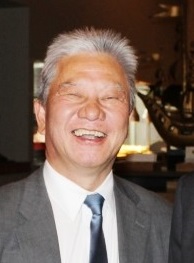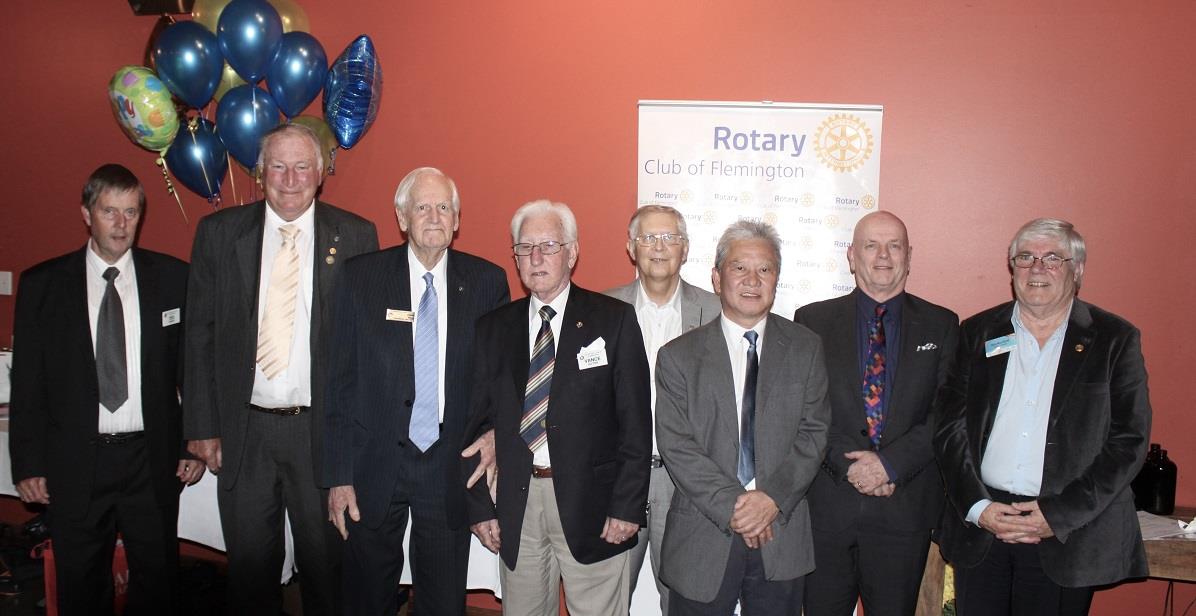 Dr Theong Ho Low, PHF was a Charter member of the Rotary Club of Flemington in 1987.
Dr Theong Ho Low, PHF was a Charter member of the Rotary Club of Flemington in 1987.He was a long serving GP in Pin Oak Crescent Flemington and was renowned for his care and compassion, especially in assisting with medical aid to south east Asia.
Theong was an early member of ROMAC - the Rotary Overseas Medical Aid program for children and he encouraged the club to support this work bringing children from Vietnam and the Philippines to Melbourne.
In 1996 together with PP Allan Bruno and the club was instrumental in bringing the Boisin conjoined twins from Papua New Guinea to Melbourne for life saving surgery.The Bosin Twins | Rotary Club of Flemington Kensington (rotaryflemington.org.au)
Theong is survived by his wife, childhood sweetheart Sue and our sympathies are extended to her and the family.
The funeral will be held on Saturday 13thMay at 10am at Le Pine, Gen Waverley.
He was the first National ROMAC Medical Director in 2000 and in his tenure brought over 50 children to Australia for surgery.
He also supported and worked with the Western Autistic School, a personal interest of his, assisting with fundraising and treatments.
Theong also took on a role with UESCO as a medical ethics director and worked on a a team performing cleft lip/palate surgery in China. He personally sponsored the Samvedna (compassion) Project in Mussourie, Uttarakhand, North India providing care for the disabled in the surrounding villages. He started a foundation for this with Casey Tan from Rotary Carlton.
Dr Low was always willing to share his work and the stories of the children he and his foundation helped. He visited our club to report on the latest news in July 2015.


Charter members: Ted Frank, Geoff Cawsey, PDG John King {charter District Governor} , PDG Vance Hilton, Eugene Odachowski, Theong Low, John Herniman, Ken Maxfield.
From the Australian Chinese Medical Association of Victoria journal - 2006
Dr Theong Ho Low should have been an architect. In fact, in a sense, that’s what he has become. But rather than designing hospitals (as he has done in Malaysia), he has become an architect of hope for dozens of patients with life-crippling diseases.
As the co-ordinator of mercy missions to bring children and young adults from Third World countries with debilitating and sometimes life threatening deformities to have surgery in Australia, he has become an inspiration to many and a minor celebrity within the local Vietnamese community, where he is highly regarded for his charitable work.
By his own admission, Dr Low never wanted to be a doctor. He excelled at mathematics and physics as a school student in Kelang, Malaysia, and envisaged a career as a nuclear scientist, computer programmer or electronic engineer. However, there were very few job prospects for such graduates in Malaysia at the time, and “as a matter of desperation” he chose Medicine when the chance came to study in Australia.
For overseas students there is always the challenge of adapting to a new culture, in addition to the rigours of study. Theong reflects on his days at Melbourne University as a period of awkward adjustment to a life of independence (away from his parents and four older brothers), finding his way in a foreign land (as he recalls: “The lecturers didn’t speak English, they spoke Australian. I could never understand what they were saying!”).
After a short break from his medical studies to marry his high school sweetheart Sue, Dr Low returned to Melbourne with his new wife to complete his degree and enter his internship at the old Queen Victoria Hospital.
He then undertook a course in family medicine which led to a career in General Practice. In the mid 1980’s Dr Low bought an existing surgery in Flemington. Aside from a brief interlude as a designer for a new hospital in Malaysia (which showcased another of his natural talents and interests), Theong has managed to build up a busy general practice, with a large proportion of his patients being of Chinese background.
It was soon after starting this practice that Dr Low was invited to be a foundation member of the Rotary Club of Flemington. Through the Club, he took the opportunity to engage in local community activities, and after being appointed Chairman of Community Services, he became involved in numerous projects, including fund raising for the Western Autistic Centre in Ascot Vale.
But it was the plight of a child from the Philippines which introduced him to a service which reached out far beyond the confines of inner Melbourne. The child was brought to Australia through the Rotary Overseas Medical Aid for Children* (ROMAC) program, which was formed over 20 years ago by a Rotarian from Bendigo. Its aims were (and still are) to bring children under the age of fifteen from the Asia/Pacific Region to Australia for lifesaving and dignity restoring surgery, where those surgeries are not available in their home country.
Theong embraced the concept of ROMAC enthusiastically, progressing to become the first National Medical Director, and then National Operations Director for ROMAC. His hard work and dedication were matched only by that of his surgeon collaborators, and are reflected in the remarkable success of the program under his stewardship. ROMAC provided a suitable platform for his skills as a project manager as well as his knowledge as a doctor.
During his time as Director, a total of more than 50 children with disorders ranging from acute burns, intracranial tumours, orthopaedic deformities to severe congenital heart and cranio-facial deformities were brought out to Melbourne from 17 different countries in the Asia Pacific region. They were treated in all of the major Children’s Hospitals of Melbourne, Sydney, Adelaide, Brisbane and the Gold Coast as well as several private hospitals in many regional areas.
One such case, which was widely publicised at the time, was the Bosin Siamese twins from Papua New Guinea, who were success[1]ully separated and are now, according to Theong, thriving well as “two beautiful kids”. The joy of seeing a smile return to the faces of patients and their families who had long given up hope, has been its own reward for Theong. It is the practice of medicine in its purest form: the restoration of a broken body and hope for the future with no contract other than that of a special and lasting friendship.
In 2002 Theong was invited to join the ACMAV Committee by then President, Dr Benny Foo, who had decided to expand the Association’s activities with a more community based focus. Theong brought to the ACMAV his vast experience, without which an organisation of doctors might (surprisingly) otherwise struggle to bring a patient from a developing country for surgery. Finding a suitable patient, a hospital administrator and staff agreeable to be involved in charity work, organising the long-distance medical assessment, visa requirements and transportation, in addition to locating carer families in Australia who share a language and cultural background with the patient, present a sizeable load of potential logistical nightmares.
To date these tasks have been entirely conducted by Theong himself, on behalf of the ACMAV. Furthermore, such projects, although carried through by volunteers, are not without substantial costs, particularly for transportation and hospital care, and through his reputation alone Dr Low has been able to raise funds from community sources. The success of the ACMAV’s first case, a young girl requiring repair of a large facial encephalocoele, prompted further donations from individuals and the Lions Club of Melbourne Chinese, allowing for more overseas projects to continue in the future. The most recent ACMAV patient brought to Melbourne from Vietnam, an unfortunate victim of horrific burns, illustrates the pivotal role played by Dr Low. Since her tragic accident, Ms Hanh Hong had been living in a monastery, hidden from the world and in tremendous discomfort. It was an Australian Vietnamese lady from Adelaide, on hearing of Ms Hong’s plight while in Vietnam, who sought to offer help, and it was through hearing of Dr Low’s previous work that she located him and sought his assistance. Ms Hong has now had several operations, organised by Dr Low and performed by Mr Ian Holten (a Plastic Surgeon) at the St John of God Hospital in Geelong to restore vital function to her face and body. Just as importantly, she now has a renewed outlook on life and displays a greater self confidence. Although she will forever be limited by her previous scars, she will now have the prospect of enjoying a more fulfilling life.
Although Theong is quick to acknowledge the dedication and generosity of his surgical colleagues, it has been his quiet work behind the scenes which brings forth such remarkable outcomes. The true benefits have not only been to the patients and their families, but through the inspiration that his work has generated in others, there has been a sense that we can all contribute in some way to bringing hope to those whose lives might otherwise be filled only with despair. ACMAV has provided Dr Low with the opportunity to continue with the tremendous work which he began with ROMAC. In turn, we have been able to witness for ourselves, the devotion he has towards helping this special group of patients.
In the role of rebuilding people’s lives, Theong Low has been both architect and master builder. *ROMAC has since changed its name to Reaching Overseas with Medical Aid for Children.
